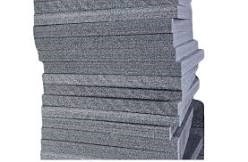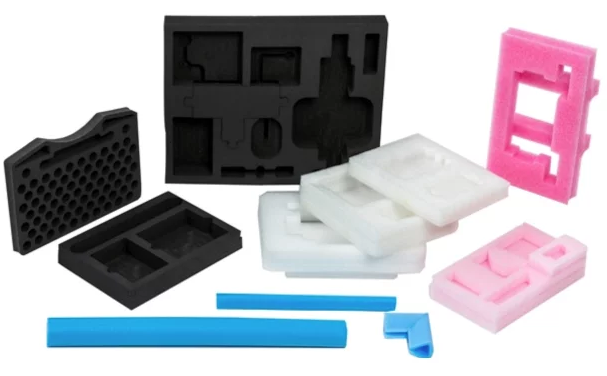In the dynamic world of packaging materials, polyethylene foam, a flagship offering from BlueRose Packaging, emerges as a versatile and indispensable player. This lightweight and resilient material have gained immense popularity across industries for its myriad applications and unique properties.
Understanding Polyethylene Foam
What is Polyethylene Foam?
Polyethylene foam, or PE foam, is a closed-cell material derived from ethylene polymerization. This results in a durable, lightweight, and flexible foam with diverse applications. Its closed-cell structure offers resilience, making it ideal for protective packaging, insulation, sports equipment, and automotive uses. Polyethylene foam stands as a versatile solution, showcasing durability, flexibility, and adaptability in various industries.
Key Properties of Polyethylene Foam:
Discover the exceptional qualities that make PE foam an indispensable packaging material.
- Lightweight:
Despite its durability, polyethylene foam maintains an impressive lightweight profile, making it an exceptional choice for industries where weight plays a crucial role. This feature is particularly advantageous in applications where minimizing overall weight is a priority, such as in aerospace or automotive packaging.
- Shock Absorption:
The closed-cell structure of PE foam not only contributes to its lightweight nature but also provides unparalleled shock absorption capabilities. This makes it an ideal material for safeguarding delicate or fragile items during transportation, ensuring they reach their destination intact and undamaged. Whether its electronics, glassware, or sensitive machinery, PE foam offers a reliable shield against impact.
- Water Resistance:
Thanks to its closed-cell structure, PE foam exhibits impressive water resistance. This characteristic prevents the absorption of moisture, making it a dependable choice for packaging materials that need to maintain their structural integrity even in humid or damp conditions. This water-resistant quality adds an extra layer of protection for items susceptible to damage from moisture.
- Thermal Insulation:
Beyond its protective features, polyethylene foam showcases excellent thermal insulation properties. This makes it a valuable asset in applications where temperature control is crucial. Whether used as insulation in construction or as a protective layer for temperature-sensitive products during transit, PE foam adds versatility by contributing to thermal stability.
- Customizable:
One of the standout features of polyethylene foam is its high degree of customization. Manufacturers can tailor the foam to meet specific requirements, allowing for the creation of bespoke packaging solutions. Whether it’s crafting inserts for uniquely shaped products or ensuring a precise fit for sensitive equipment, the customization options of PE foam cater to diverse industry needs.
- Cost-Effective:
Beyond its protective and customizable features, PE foam proves to be a cost-effective choice for packaging. Its affordability, coupled with the ability to reduce product damage during transit, translates to overall cost savings for businesses. The combination of protective qualities and economic benefits makes polyethylene foam a practical and budget-friendly solution.
- Eco-Friendly:
PE foam aligns seamlessly with sustainability goals, standing out as an eco-friendly packaging option. Being recyclable and reusable, it contributes to reducing environmental impact. By choosing PE foam, businesses not only benefit from its protective qualities but also make a positive stride towards adopting more sustainable and environmentally conscious packaging practices.
Applications of Polyethylene Foam

- Packaging Solutions:
- Cushioning Material: Its shock-absorbing qualities make it a preferred choice for protecting delicate items during shipping.
- Insulation Inserts: Polyethylene foam is often used to create custom insulation inserts for temperature-sensitive products.
- Automotive Industry:
- Interior Components: Used for fabricating seat cushions, headliners, and door panels due to its comfort and durability.
- Acoustic Insulation: The sound absorption properties of PE foam enhance vehicle acoustics.
- Construction Sector:
- Expansion Joint Filler: Its compressibility and flexibility make polyethylene foam an excellent choice for filling expansion joints in construction projects.
- Insulation: Used as insulation material in buildings, providing thermal and acoustic benefits.
- Sports and Recreation:
- Protective Gear: Commonly used in the production of helmets, knee pads, and other protective gear due to its impact-resistant nature.
- Floating Devices: Its buoyancy makes it suitable for crafting flotation devices for water activities.
Key differences between Polyethylene Foam and Polyurethane Foam
|
Feature |
Polyethylene Foam |
Polyurethane Foam |
|
Material Composition |
Made from closed-cell, cross-linked polyethylene | Derived from a polymer, offering open or closed-cell structures |
|
Density |
Generally lower density | Varied density options, including high-density formulations |
|
Flexibility |
Offers good flexibility and resilience | Exhibits flexibility, with some variations depending on formulation |
|
Durability |
Durable, resistant to moisture and chemicals | Highly durable, can withstand heavy use and diverse environments |
|
Cushioning Properties |
Excellent shock absorption | Superior cushioning, often used in high-impact applications |
|
Water Absorption |
Resistant to water absorption | Can absorb water, but some formulations offer water resistance |
|
Cost |
Generally more cost-effective | Can be more expensive, especially high-density or specialized formulations |
|
Applications |
Widely used in packaging and insulation | Commonly found in furniture, mattresses, and high-impact applications |
|
Environmental Impact |
Generally more environmentally friendly | Environmental impact varies based on formulation and production processes |
Conclusion:
In concluding our exploration of PE, we shine a spotlight on BlueRose Packaging—an industry leader committed to excellence in packaging solutions. BlueRose Packaging not only provides premium PE foam but also offers a comprehensive range of packaging solutions. Our expertise extends to Charcoal Foam Packaging, EPE Foam Packaging, EPS Foam Packaging, Packaging Foam Sheets, and Packing Foam Rolls, ensuring that we meet all your packaging needs with quality and efficiency.
Polyethylene foam, a cornerstone of BlueRose Packaging’s offerings, exemplifies innovation and reliability in the realm of packaging materials. As industries seek efficient, cost-effective, and environmentally conscious solutions, poly foam from BlueRose Packaging remains a frontrunner in meeting these demands. Join us in celebrating the marvels of polyethylene foam—a versatile solution that combines practicality with sustainability.
Frequently Asked Questions (FAQs):
Q: What are the key advantages of polyethylene foam in packaging?
A: Polyethylene foam provides excellent shock absorption, is lightweight, water-resistant, and customizable, making it an ideal choice for protecting fragile items during shipping.
Q: Is polyethylene foam environmentally friendly?
A: Yes, polyethylene foam is recyclable and reusable, contributing to sustainable packaging practices.
Q: Can polyethylene foam be used in construction projects?
A: Certainly, its compressibility and flexibility make it an excellent choice for filling expansion joints and providing thermal insulation in buildings.
Q: How does the cost of polyethylene foam compare to other packaging materials?
A: Generally, polyethylene foam is more cost-effective compared to some alternative materials, offering a balance between affordability and performance.
Q: Can polyethylene foam withstand extreme temperatures?
A: Polyethylene foam has good temperature resistance, but the exact range can vary. It’s advisable to check the specific formulation or consult with the manufacturer for applications in extreme temperature environments.
Q: Is polyethylene foam suitable for use with food products?
A: Yes, polyethylene foam is often considered safe for use with food products. However, it’s essential to verify the specific product’s compliance with food safety regulations.
Q: Can polyethylene foam be easily customized for specific packaging needs?
A: Absolutely, polyethylene foam is highly customizable. It can be easily cut, shaped, and molded to fit specific packaging requirements, providing tailored solutions for various industries.
Q: What is the lifespan of polyethylene foam in typical packaging applications?
A: Polyethylene foam has a long lifespan, and its durability ensures that it can withstand the rigors of shipping, making it a reliable choice for extended use in packaging.

